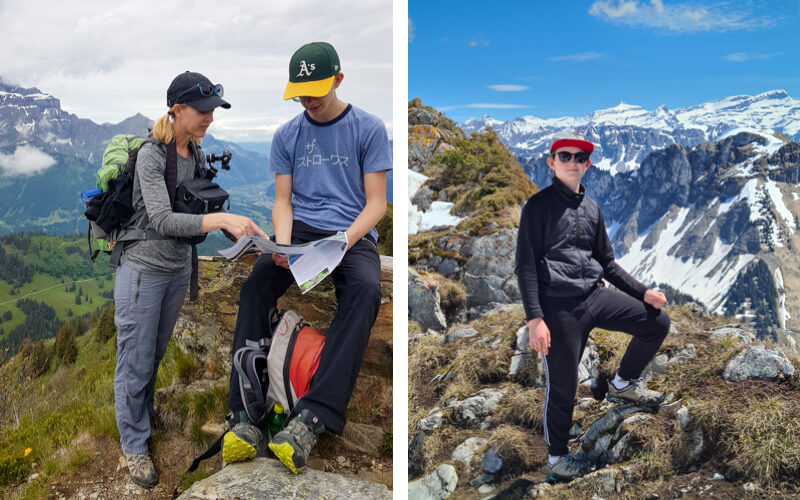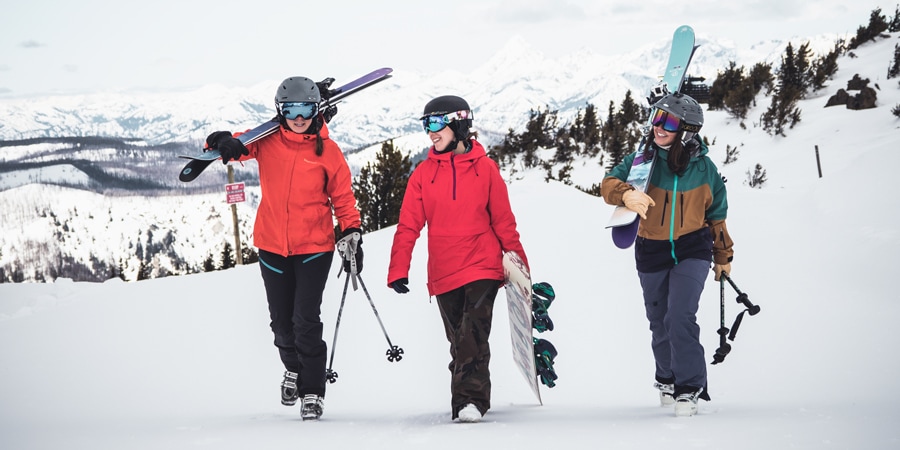Activewear is clothing that has been specifically designed to be used in physical activities. The clothing is typically water-wicking.
Base Layer- The base layer is the very first layer of clothing worn over the skin. The base layer must be wicking in moisture, and designed to move sweat away from your body. The base layer is generally made up of materials like merino, or synthetics such as polyester.
Insulating layer - The insulation layer provides warmth by retaining the body's heat. For insulation, many prefer lightweight jackets made from down or fleece. They are light, breathable and provide great warmth.
Outer Layer/Shell: This layer is also known as the shell layer and protects from wind, rain, and snow. It must be also waterproof and windproof. The most common outer layer options are waterproof jackets and softshell jackets that offer protection against the elements but allow moisture to go away.
Also, consider the following:
Choose clothing that has adjustable features like the waistbands, hoods and cuffs. It allows you to customise the fit as well as keep out any drafts or keep out rain.
Breathability- Choose clothing that lets moisture escape to prevent overheating and excessive sweating. Fabrics that feature mesh panels or membranes with breathable properties are a great way to help ventilate.
Layering Flexibility- Opt for garments that are easily layered and permit simple removal or adding layers as temperatures and activity levels change.
Weather and activity specificityConsider the kind of outdoor activity that you're planning to do and what weather conditions are likely to be expected. Different sports might require different gear. For example you may require moisture-wicking clothing, quick drying clothes for intense activities, or additional insulation for cold weather activities.
The best layers for outdoor use depend on a variety of factors, including weather conditions, the intensity of physical exercise, as well as personal preferences. Pick high-end apparel that will meet your individual needs and provides the right balance between protection along with comfort and mobility. Check out the top men's wool thermals for blog advice including merino wool thermal, merino wool neck gaiter, best thermals for men, baselayer merino, thermal wear near me, summer wool and arctic norway.

What Is The Importance Of Base Layers In Outdoor Clothing?
There are a few points you need to be aware of when it comes outdoor clothing. Materials used in base layers can include synthetic fabrics, like nylon or polyester, and Merino. Merino Wool is known for its superior temperature control and odor-resistance. Additionally, it has natural moisture-wicking properties. Synthetic fabrics are durable, have good moisture management and quick drying capabilities.
Base Layers The layers are made to remove moisture from the skin, keeping you dry. The fabric that wicks moisture pulls sweat away from the body and enables it to evaporate faster. This allows you to regulate your body temperature, and helps prevent discomfort caused by wetness.
Insulation Layers - The base layers can offer some insulation by capturing warm air in your skin. They assist in controlling your body temperature, keeping your body warm in cold weather and cool in hot weather. Base layers come in various thicknesses, so pick one that best suits your lifestyle and your climate.
Fit - Base layers must be snug, but not getting too tight. A snug fit will allow for efficient moisture transfers and optimal thermal insulation. It also makes it easy to layering of additional clothing without discomfort or excess bulk.
Merino Wool Base Layers are known for their anti-odor natural properties. They are invulnerable to bacteria that cause odor and can be worn for long periods without washing. The synthetic base layer fabrics typically have anti-odor treatments.
The base layer is the heart of layering outdoor clothes. They are usually worn as the upper layer next to the skin. Base layers help regulate temperatures and moisture. They also provide a an incredibly comfortable and practical base for layers.
Base Layers and Activity Considerations - The base layer you choose is based on the activity you are doing and the weather conditions. When you're doing high-intensity sports, look for lightweight and permeable base layers that can provide efficient moisture management. For colder climates, go for more dense and insulation-rich base layers to keep the warmth.
Care and Maintenance- Make sure to adhere to the recommendations from the manufacturer to get the most effective performance and durability of your base layer. For some base layers made from merino wool, gentle washing and drying might be necessary to ensure the quality of the material.
Base layers are a vital component of your outdoor clothing system. They control your body temperature, manage moisture, and keep you comfortable when taking part in outdoor activities. The right choice of base layers according to the materials appropriate for the wearer and their weather conditions can significantly enhance the enjoyment of your outdoor activities. See the top rated women's thermals near me for website info including baselayer merino, merino wool mid layer, best wool base layer, skiing base layers, hiking clothes for women, 100% yak yarn and merino wool mid layer.

What Are The Essential Aspects To Take Into Consideration When Selecting Outdoor Clothing That Is Air-Conditioned?
The ability to breathe is a key feature of clothing for outdoor use. This is particularly true when you're engaged in physical activities, or under various weather conditions. Here's what you need to be aware of when it comes to breathability in outdoor clothes. Definition: Breathability refers to the ability of a clothing item or fabric to allow water vapor (sweat) to drain away from your body, and protecting you from external elements like rain or wind. It helps regulate your body temperature, ensuring you stay at a comfortable temperature during activities that produce heat and perspiration.
Breathable Fabrics: These fabrics are designed for moisture management. They help to wick away moisture and move it away from the skin where it evaporates more quickly. This prevents sweat from getting accumulated on your skin and helps reduce discomfort.
Fabric Technologies- Various fabric technologies and constructions can improve the ability to breathe of outdoor clothing. Some common examples include-
Moisturewicking Fabrics: The fabrics that have moisture-wicking capabilities will draw water away from the skin. They also spread the water over a larger area, which allows it to evaporate more quickly.
Permeable Membranes Breathable membranes, such as GoreTex or eVent are made of microscopic holes that allow moisture vapor escape while still providing windproofness and waterproofness.
Ventilation Options - Clothing that has ventilation options like pit zips or mesh panels allows for more airflow and breathability, particularly when you are engaged in intense sports.
LayeringBreathability is a crucial factor to take into account when layering outdoor clothing. Each layer of clothing should be constructed in a manner that allows for moisture to flow easily between layers and away your body. The mid-layers and the base layer need to effectively absorb moisture. The outer layers must allow moisture vapour to go away.
Climate and Activity Level- The amount of breathability that you need in your outdoor clothes will vary depending on the climate and activity level. Warmer climates and high intensity activities may require greater breathability to manage the moisture effectively and prevent overheating.
Personal Comfortable Clothing - Breathable clothes increase your outdoor comfort by preventing heat buildup and reducing the risk of feeling sweaty or clammy. It regulates body temperature, which helps you remain cool and dry for longer periods.
Durable Water Repellency (DWR)- Some breathable clothings have a tough water repellent (DWR) surface on their outer surface. DWR is a coating that prevents outer fabrics from becoming saturated with water. This helps maintain breathability since water is unable to block the fabric or pores.
Maintenance - To keep the breathability of your outdoor clothing, it is recommended to follow the maintenance instructions given by the manufacturer. Regularly cleaning and proofing can assist in restoring DWR treatments back to their initial efficiency, and ensure optimal breathing.
Knowing the breathability characteristics of outdoor apparel will aid you in making an informed decision when choosing garments to suit different activities and conditions. Outdoor clothing that is breathable feels comfortable lets moisture be controlled effectively and can enhance the overall experience. Have a look at the best thermals base layers for blog info including himalayan clothing, best thermals, skiing base layer, warmest merino wool base layer, best merino wool base layer, jersey wool and base layer shorts.

What Are The Advantages Of Thermal Yak Sweaters As Well As Pants?
Thermal leggings made of Yak wool and sweaters as well as pants provide many benefits due to the unique properties of that yak. Yak Wool is known for its exceptional insulation capabilities. It has a natural ability to hold air in its fibers, which provides exceptional warmth in cold weather conditions. Yak clothes such as sweaters, pants, and leggings will keep you warm, comfortable, and cozy.
Yak is very gentle against skin and provides a comfortable layer of thermal clothing. It is suitable for those who suffer from sensitive skin because it does not itch like other varieties of wool from sheep.
Moisture Control- Yak wool is a moisture-wicking material, like all types of wool. It is able to absorb moisture, and then release the vapor to the air. This helps to keep you dry and also reduces the build-up of sweat. It regulates the body's temperature, and decreases the chance of feeling uncomfortable and damp during exercise.
Yak is antimicrobial and can stop the growth of odor-causing bacteria. The clothes made of Yak wool are cleaner and last longer, even after long-term use.
Breathability - Yak wool is breathable, allowing the air to circulate, and heat to escape as required. This prevents excessive sweating or overheating in sporting activities. The breathability and temperature regulation of wool yaks are a major factor in overall comfort.
Yak Wool is lightweight and compact, and even though it's warm, it's comfortable to wear. Yak-wool clothing can be folded or rolled to conserve space, making them perfect for outdoor activities and travelling.
Yak wool's natural insulation properties can help maintain body temperature in warm and cold environments. It helps keep your body warm when temperature is lower but assists in dispersing excess heat when the temperature increases.
Yak wool can be considered an environmentally friendly and sustainable material. Yaks can adapt to harsh mountain climates, and need minimal interactions with humans to ensure their well-being. In addition, yak wool is biodegradable, which reduces its environmental impact compared to synthetic materials.
It is important to know that the performance and specific benefits of yak garments will vary depending on their construction and quality. Be sure to buy yak thermal sweaters, leggings, or pants from brands that you trust and use only high-quality wool.
Yak thermal clothing is an excellent choice for warmth, comfort. It also provides the ability to control humidity and breathe. They are an eco-friendly and natural option for those who want reliable insulation. Follow the best wool athletic wear for website tips including womens base layers, mens ski base layers, koras, wool long johns, kora for sale, wool base layer mens and 100% yak yarn.
